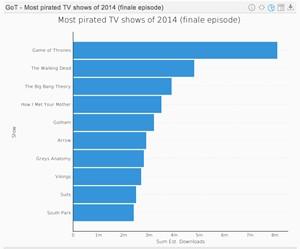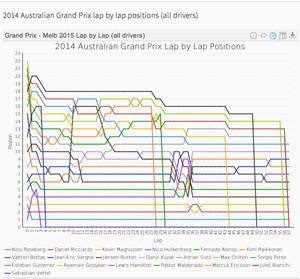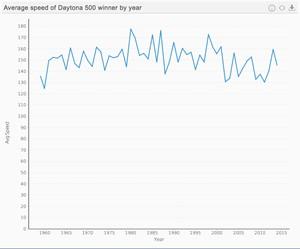Data Visualization reveals most popular Game of Thrones ep.
By Eshan Wickrema and Lachlan James
Alright all you Game of Thrones (GoT) buffs. Here’s a ‘curly one’ for you: Which episode of GoT as pulled the biggest audience so far?
Game of Thrones US viewership by episode via HBO
How’d you go? Did you guess right?
Insights:
Game of Thrones: A growing following
Using Business Intelligence and data visualization, it’s immediately evident that GoT has consistently increased its viewership since its debut episode aired on America’s HBO, 17th April 2011, to an audience of 2.2 million. In fact, episode 401 (the first installment of the fourth season) set a new HBO audience record for a season premiere, with a total of 6.64 million American’s tuning in to watch.
Despite all the hype surrounding the final episode of season four (which we discussed in first GoT data blog, Game of Thrones: The most pirated TV show), it’s the seventh installment of the fourth season (407) – “Mockingbird” – that holds the US viewership record for the initial HBO showing. However, it is important to note that these figures are estimations of the number of US viewers that tuned into watch each episode on HBO. As our inaugural GoT data blog highlighted, online piracy has expanded the show’s popularity immensely – both in total audience numbers and the number of different countries from which its audience reside.
Whilst there is a clear upwards trend in the estimated HBO viewership per episode, and hence per season, there are some notable exceptions to that rule. As noted above, the estimated HBO viewership has consistently dipped for a mid-series episode in May during each season:
Could this be representative of mid-season fatigue, where audiences are hooked-in for the start of a series, drop-off slightly in the middle, and rejoin for the suspenseful series climax? Or, is it indicative of a bigger problem for the show? Does it suggest that viewers are abandoning GoT mid-season, with ‘new converts’ simply replenishing overall HBO viewership numbers towards the end – and at the beginning – of each series?
And, these hypotheses lead to another question: Will audience fatigue – and a saturated market, combined with many other factors – see GoT struggle to grow its total audience numbers into the future?
Increase in total Game of Thrones viewership by season
Insights:
Is the growth in Game of Thrones’ popularity sustainable?
Despite the slower percentage increase in total audience size from seasons two to three (30.86%) – compared to seasons one to two (50.89%) – of GoT, it seems that this trend may now be reversing.
Adding the number of estimated HBO viewers per episode together to reach a total per season viewership figure (as we’ve done above), we’re able to see that the total audience gain increased at a faster rate from season three (49.66 million) to season four (68.46 million), compared to audience growth from season two to three, with a total audience increase of 37.86%. Aside from the general groundswell of support for GoT, some have attributed the reinvigorated audience growth rates to the social media frenzy that ensued post “The Red Wedding” episode.
Following the drama of season four, which included such watershed episodes as “The Lion and the Rose” (also known as the Purple Wedding) and “The Mountain and the Viper”, can we expect to see another spike in viewership for season five? And, will the season five launch on April 12th break yet another HBO viewership record for a series premiere?
We recommend
Data Visualization: Game of Thrones the most pirated TV show >

Data viz predicts 2015 Cricket World Cup high scoring games >

Data visualization predicts 2015 Australian Grand Prix >

Assessing Daytona 500 championship with Data Visualization >

Alright all you Game of Thrones (GoT) buffs. Here’s a ‘curly one’ for you: Which episode of GoT as pulled the biggest audience so far?
Game of Thrones US viewership by episode via HBO
How’d you go? Did you guess right?
Insights:
- Episode seven of season four, “Mockingbird”, has the highest estimated HBO US viewership on any GoT episode to date at 7.2 million (originally aired on HBO, 18th May 2014)
- The episode with the second highest estimated HBO viewership inside the US was the next episode, “The Mountain and the Viper“, with an audience of 7.17 million
- Each season has progressively attracted a larger audience, building on its growing popularly over time
- Estimated HBO viewership has consistently dipped for a mid-series episode in May during each season
Game of Thrones: A growing following
Using Business Intelligence and data visualization, it’s immediately evident that GoT has consistently increased its viewership since its debut episode aired on America’s HBO, 17th April 2011, to an audience of 2.2 million. In fact, episode 401 (the first installment of the fourth season) set a new HBO audience record for a season premiere, with a total of 6.64 million American’s tuning in to watch.
Despite all the hype surrounding the final episode of season four (which we discussed in first GoT data blog, Game of Thrones: The most pirated TV show), it’s the seventh installment of the fourth season (407) – “Mockingbird” – that holds the US viewership record for the initial HBO showing. However, it is important to note that these figures are estimations of the number of US viewers that tuned into watch each episode on HBO. As our inaugural GoT data blog highlighted, online piracy has expanded the show’s popularity immensely – both in total audience numbers and the number of different countries from which its audience reside.
Whilst there is a clear upwards trend in the estimated HBO viewership per episode, and hence per season, there are some notable exceptions to that rule. As noted above, the estimated HBO viewership has consistently dipped for a mid-series episode in May during each season:
- Season 1: Episode 7 (5th May, 2011 – “You win or you die”), with 2.4 million HBO viewers
- Season 2: Episode 9 (27th May, 2012 – “The Black Water”), with 3.38 million HBO viewers
- Season 3: Episode 7 (12th May, 2013 – “The Bear and the Maiden Fair”), with 4.84 million HBO viewers
- Season 4: Episode 6 (11th May, 2014 – “The Laws of Gods and Men”), with 6.4 million HBO viewers
Could this be representative of mid-season fatigue, where audiences are hooked-in for the start of a series, drop-off slightly in the middle, and rejoin for the suspenseful series climax? Or, is it indicative of a bigger problem for the show? Does it suggest that viewers are abandoning GoT mid-season, with ‘new converts’ simply replenishing overall HBO viewership numbers towards the end – and at the beginning – of each series?
And, these hypotheses lead to another question: Will audience fatigue – and a saturated market, combined with many other factors – see GoT struggle to grow its total audience numbers into the future?
Increase in total Game of Thrones viewership by season
Insights:
- The largest percentage increase in estimated GoT viewership on HBO occurred from season one (25.15 million) to season two (37.95 million), for a total audience increase of 50.89%
- The show’s popularity grew at a slower rate from season two (37.95 million) to season three (49.66 million), for a total audience increase of 30.86%
- Total audience gain increased at a faster rate from season three (49.66 million) to season four (68.46 million), compared to audience growth from season two to three, with a total audience increase of 37.86%
Is the growth in Game of Thrones’ popularity sustainable?
Despite the slower percentage increase in total audience size from seasons two to three (30.86%) – compared to seasons one to two (50.89%) – of GoT, it seems that this trend may now be reversing.
Adding the number of estimated HBO viewers per episode together to reach a total per season viewership figure (as we’ve done above), we’re able to see that the total audience gain increased at a faster rate from season three (49.66 million) to season four (68.46 million), compared to audience growth from season two to three, with a total audience increase of 37.86%. Aside from the general groundswell of support for GoT, some have attributed the reinvigorated audience growth rates to the social media frenzy that ensued post “The Red Wedding” episode.
Following the drama of season four, which included such watershed episodes as “The Lion and the Rose” (also known as the Purple Wedding) and “The Mountain and the Viper”, can we expect to see another spike in viewership for season five? And, will the season five launch on April 12th break yet another HBO viewership record for a series premiere?
We recommend
Data Visualization: Game of Thrones the most pirated TV show >

Data viz predicts 2015 Cricket World Cup high scoring games >

Data visualization predicts 2015 Australian Grand Prix >

Assessing Daytona 500 championship with Data Visualization >
